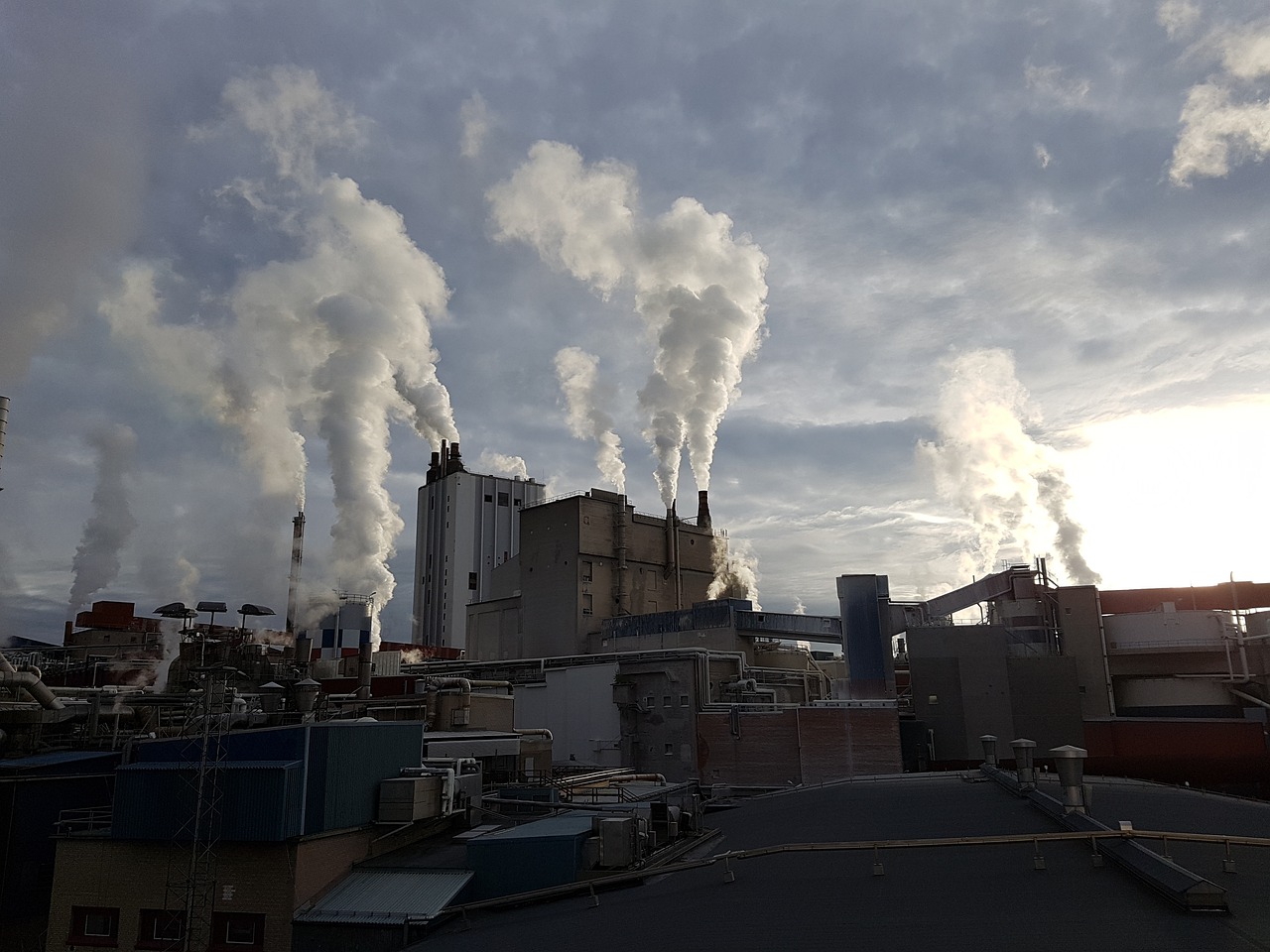Tackling Environmental Injustice in the Age of Climate Change
This article explores the intersection of environmental justice and climate change, highlighting the challenges faced by marginalized communities and proposing actionable solutions to address these pressing issues.
Environmental injustice refers to the disproportionate impact of environmental hazards on marginalized communities. Historically, these communities have been the last to receive the benefits of environmental protections while being the first to suffer from the consequences of pollution and climate change. This unfair distribution of environmental risks is not just a contemporary issue; it has deep roots in systemic inequalities, often linked to race, income, and geographic location. As we face a climate crisis that threatens the very fabric of our society, understanding the historical context of environmental injustice becomes crucial. It’s like trying to solve a puzzle without knowing how the pieces fit together. Without this knowledge, we risk repeating the same mistakes that have led us to this critical juncture.
Climate change exacerbates existing inequalities, affecting vulnerable populations more severely. Imagine living in a neighborhood where the air is thick with pollution, where the heat waves are more intense, and where flooding is a regular occurrence. For many marginalized communities, this is a daily reality. These populations often lack the resources to adapt to or recover from climate-related events, leading to a vicious cycle of disadvantage. For example, during extreme weather events, low-income families may find themselves without adequate shelter or access to emergency services, compounding their struggles. The reality is that climate change is not just an environmental issue; it's a social justice issue that demands our immediate attention.
To truly grasp the gravity of environmental injustice, we must look at real-life examples. Across the globe, there are communities that serve as stark reminders of how climate change and environmental hazards intersect. For instance, in New Orleans, predominantly African American neighborhoods were disproportionately affected by Hurricane Katrina, revealing systemic neglect and inadequate disaster response. Similarly, in Flint, Michigan, the water crisis highlighted how low-income residents were exposed to toxic lead, a direct result of governmental failure. These case studies are not just statistics; they are stories of resilience and struggle, urging us to take action.
Urban centers often experience higher pollution levels, severely impacting low-income neighborhoods. The correlation between urbanization, pollution, and health disparities is alarming. For instance, studies show that children living in high-pollution areas are more likely to suffer from asthma and other respiratory ailments. This isn't just about numbers; it's about lives—lives that are cut short or severely impacted because of where people live. The air quality in these neighborhoods serves as a grim reminder of the environmental injustices that persist in our cities.
On the other hand, rural populations face challenges related to resource depletion and agricultural impacts. Climate change threatens their livelihoods and food security, as erratic weather patterns disrupt farming cycles. Imagine a farmer who has spent years cultivating their land, only to watch as droughts or floods wipe out their crops. This scenario is becoming increasingly common, leaving families struggling to put food on the table. The plight of rural communities underscores the urgent need for policies that not only address climate change but also prioritize the needs of those most affected.
Effective policy measures are crucial for addressing environmental injustice. Current policies often fall short, failing to adequately protect marginalized communities from environmental hazards. We need to evaluate these policies critically and propose improvements that ensure equitable environmental protections. This might include enforcing stricter regulations on pollutants, increasing funding for community resilience projects, and ensuring that vulnerable populations have a voice in environmental decision-making. After all, how can we expect to tackle these issues without involving those who are most impacted?
Grassroots organizations play a vital role in advocating for environmental justice. These activists and community leaders are on the front lines, working tirelessly to combat the impacts of climate change. Their efforts often lead to significant changes in policy and public perception. For example, organizations that focus on clean air initiatives have successfully pushed for stricter regulations on industrial emissions, showcasing the power of collective action. When communities come together, they can create a force that is hard to ignore. This is a testament to the resilience and determination of those who refuse to accept the status quo.
We will showcase successful initiatives led by activist groups that have made significant strides in addressing environmental injustices and promoting sustainable practices. These stories are not just about victories; they are about hope and inspiration. They remind us that change is possible when we work together. From community gardens that promote food sovereignty to campaigns that demand clean water access, these initiatives demonstrate the power of grassroots activism in creating a more just and equitable world.
Engaging communities in environmental decision-making is essential. Effective strategies for fostering community involvement include holding public forums, creating educational programs, and utilizing social media to raise awareness. By empowering individuals to take part in the decision-making process, we can ensure that their voices are heard and their needs are met. It's about building a community where everyone has a stake in the outcome, where every opinion matters, and where collective action leads to meaningful change.
As climate change continues to evolve, so must our approach to environmental justice. Future trends may include a greater emphasis on intersectionality in environmental policies, recognizing that issues of race, class, and gender are interconnected. Additionally, we might see a rise in community-led initiatives that prioritize sustainability and resilience. The path forward is not just about mitigating climate change; it's about creating a just and equitable society where everyone has the opportunity to thrive.
- What is environmental injustice? Environmental injustice refers to the unequal distribution of environmental hazards, disproportionately affecting marginalized communities.
- How does climate change impact vulnerable communities? Vulnerable communities often lack resources to adapt to climate change, facing higher risks of health issues, food insecurity, and displacement.
- What can individuals do to help combat environmental injustice? Individuals can support grassroots organizations, advocate for equitable policies, and engage in community decision-making processes.

Understanding Environmental Injustice
Environmental injustice is a critical issue that has been lurking in the shadows for far too long. It refers to the disproportionate impact of environmental hazards on marginalized communities, often leaving them vulnerable and exposed to risks that more affluent populations can easily evade. This concept isn't just a buzzword; it's a reflection of systemic inequalities that have persisted throughout history and continue to shape our present and future. To truly grasp the significance of environmental injustice, we must first examine its roots and how it intertwines with current climate crises.
Historically, marginalized communities have been the first to bear the brunt of environmental degradation. Whether it's the siting of hazardous waste facilities, the pollution from industrial plants, or the lack of access to clean water, these communities often find themselves at the epicenter of environmental harm. It's as if they are living in a game where the rules are rigged against them, and the stakes are their health, safety, and well-being.
As we delve deeper into this issue, it becomes clear that environmental injustice is not merely an environmental problem; it is a social, economic, and political one as well. The intersectionality of race, class, and geography plays a significant role in determining who suffers the most from environmental hazards. For instance, studies have shown that people of color and low-income individuals are more likely to live near polluted sites and have limited access to resources that can mitigate these risks.
To illustrate this point, consider the following factors contributing to environmental injustice:
- Economic Disparities: Low-income communities often lack the financial resources to fight against environmental degradation or relocate to safer areas.
- Political Marginalization: These communities frequently lack representation in political decision-making, making it difficult for them to advocate for their rights.
- Health Impacts: Exposure to pollutants and environmental hazards leads to significant health disparities, including respiratory issues, cancer, and other chronic diseases.
As we navigate the complexities of environmental injustice, it’s essential to recognize the role of climate change in exacerbating these existing inequalities. Climate change acts as a multiplier of risks, disproportionately affecting those who are already marginalized. Extreme weather events, rising sea levels, and shifting agricultural zones are just a few examples of how climate change can devastate vulnerable communities, pushing them further into the margins.
In conclusion, understanding environmental injustice is the first step in addressing it. By acknowledging the historical context and recognizing the ongoing struggles of marginalized communities, we can begin to formulate actionable solutions that promote equity and justice. As we move forward, it is crucial to keep the conversation alive and ensure that the voices of those affected are at the forefront of environmental policy discussions.

Impact of Climate Change on Vulnerable Communities
Climate change isn’t just an abstract concept; it’s a harsh reality that disproportionately affects those who are already on the margins of society. Vulnerable communities, often characterized by low income, limited access to resources, and systemic inequalities, face the brunt of climate-related disasters. Imagine living in a neighborhood where the air is thick with pollution, where floods sweep away homes, and where the heatwaves seem to last forever. This is the daily struggle for many, and it’s only getting worse as climate change accelerates.
These communities are not just victims of chance; they are often situated in areas that are more susceptible to environmental hazards. For instance, low-income neighborhoods are frequently located near industrial sites, leading to higher exposure to toxic pollutants. According to the Environmental Protection Agency (EPA), marginalized groups face a higher risk of health problems due to their proximity to these hazardous sites. This creates a vicious cycle where poor health limits economic opportunities, further entrenching these communities in poverty.
Furthermore, the impact of climate change manifests in various ways, including:
- Extreme Weather Events: Hurricanes, floods, and wildfires are becoming more frequent and severe. Vulnerable communities often lack the resources to prepare for or recover from these disasters.
- Food Insecurity: Climate change disrupts agricultural production, leading to food shortages. Rural communities, in particular, are at risk as changing weather patterns affect crop yields.
- Health Risks: Increased heat can exacerbate pre-existing health conditions, while poor air quality from pollution can lead to respiratory issues.
To illustrate this point, let’s look at a few case studies that highlight the unique challenges faced by these communities:
| Community | Impact | Response |
|---|---|---|
| New Orleans, Louisiana | Severe flooding post-Hurricane Katrina | Community-led rebuilding initiatives |
| Flint, Michigan | Water contamination crisis | Grassroots activism for clean water |
| California Wildfire Zones | Displacement due to wildfires | Community emergency preparedness programs |
As we can see, the effects of climate change are not evenly distributed. The struggle for survival is compounded by a lack of resources, inadequate infrastructure, and systemic neglect. It’s not just about the environment; it’s about **justice**. These communities are fighting not only for their homes but for their very existence. The question remains: how can we turn the tide? By understanding the challenges they face, we can begin to formulate effective strategies that advocate for their needs and prioritize their voices in the conversation about climate change.
In conclusion, the impact of climate change on vulnerable communities is profound and multifaceted. It’s a call to action for all of us to recognize these disparities and work towards solutions that promote equity and justice. The road ahead is challenging, but with collective effort and commitment, we can forge a path that leads to a more sustainable and equitable future for everyone.
- What is environmental injustice? Environmental injustice refers to the disproportionate impact of environmental hazards on marginalized communities.
- How does climate change affect vulnerable communities? Vulnerable communities face heightened risks from extreme weather, food insecurity, and health issues due to climate change.
- What can be done to address these issues? Effective policy measures, community engagement, and grassroots activism are crucial for combating environmental injustice.

Case Studies of Affected Communities
When we talk about environmental injustice, it’s crucial to ground our discussion in real-world examples that highlight the struggles of marginalized communities. These case studies not only illustrate the impacts of climate change but also reveal the systemic issues that perpetuate inequality. Let’s dive into a few poignant examples that showcase the stark reality faced by these communities.
One of the most striking cases can be found in New Orleans, where the aftermath of Hurricane Katrina in 2005 exposed severe disparities in recovery efforts. While affluent neighborhoods received immediate assistance and resources, low-income areas predominantly inhabited by African American residents faced prolonged neglect. The floodwaters did not just wash away homes; they also swept away the community's access to healthcare, education, and economic stability. This incident serves as a glaring reminder of how climate-related disasters can exacerbate existing inequalities.
Another poignant example is the situation in Flint, Michigan, where a water crisis emerged due to the city’s decision to switch water sources. The corrosive water from the Flint River leached lead from old pipes, exposing residents—many of whom were low-income and predominantly African American—to toxic water. The long-term health effects, particularly on children, are devastating. This case highlights how environmental policies can disproportionately impact vulnerable populations, raising critical questions about accountability and justice.
In California, the wildfires that have ravaged communities in recent years also shine a light on environmental injustice. Many of the hardest-hit areas are low-income neighborhoods where residents have less access to resources for fire prevention and recovery. The Camp Fire in 2018, for instance, devastated the town of Paradise, displacing thousands. While wealthier areas have the means to invest in fire-resistant infrastructure, poorer communities are left to fend for themselves, often with tragic results.
To better understand the scope of these issues, let’s take a look at a table summarizing the impacts on different communities:
| Community | Impact of Climate Change | Key Issues |
|---|---|---|
| New Orleans | Hurricane damage and flooding | Disparities in recovery efforts |
| Flint, Michigan | Water contamination | Health risks, lack of accountability |
| California | Wildfires | Resource inequity, displacement |
These case studies are not just isolated incidents; they reflect a broader trend of environmental injustice that is exacerbated by climate change. Each story is a call to action, urging us to recognize the systemic inequalities that exist and to work towards solutions that ensure all communities are treated equitably, especially in times of crisis. By amplifying these voices and experiences, we can better advocate for policies that prioritize the needs of the most vulnerable among us.
- What is environmental injustice? Environmental injustice refers to the unequal distribution of environmental benefits and burdens, often affecting marginalized communities disproportionately.
- How does climate change exacerbate environmental injustice? Climate change intensifies existing vulnerabilities, leading to more severe impacts on low-income and marginalized communities, which often lack the resources to adapt or recover.
- What can be done to address environmental injustice? Policy reforms, community engagement, and grassroots activism are essential to create equitable solutions that protect vulnerable populations from environmental hazards.

Urban Areas and Pollution
Urban areas are often bustling hubs of activity, innovation, and culture, but they also come with a darker side—**pollution**. As cities expand and populations grow, the air we breathe and the water we drink can become contaminated, leading to dire health consequences, particularly for low-income communities. It's a troubling paradox: while urbanization can drive economic growth and opportunity, it can also exacerbate existing inequalities. Have you ever wondered why the air in some neighborhoods feels heavier, or why certain communities seem to suffer more from respiratory issues? The answer often lies in the environmental injustices that plague these urban landscapes.
To understand the impact of pollution in urban areas, we need to look at the sources. Industrial facilities, vehicle emissions, and inadequate waste management systems all contribute to the toxic cocktail of pollutants that can fill the air and contaminate water sources. For instance, neighborhoods located near highways or factories often experience higher levels of particulate matter and volatile organic compounds, which can lead to serious health problems like asthma, heart disease, and even cancer. According to the Environmental Protection Agency (EPA), **low-income communities and communities of color** are disproportionately affected by these pollutants, leading to a cycle of health disparities that is hard to break.
Moreover, the effects of urban pollution extend beyond immediate health risks. They can also affect **mental health** and overall quality of life. Imagine living in a neighborhood where the air is thick with smog, where children can't play outside due to concerns about their health, and where access to clean parks and recreational areas is limited. This environment can lead to increased stress, anxiety, and a sense of hopelessness among residents, further entrenching the cycle of poverty and disadvantage.
The correlation between urbanization, pollution, and health disparities is stark. A study conducted in several major cities revealed that neighborhoods with higher pollution levels also had a higher incidence of health issues among residents. The table below summarizes some key findings from this research:
| Pollutant Type | Health Impact | Affected Demographic |
|---|---|---|
| Particulate Matter (PM2.5) | Respiratory Issues, Heart Disease | Low-income Communities |
| Nitrogen Dioxide (NO2) | Asthma, Lung Infections | Children and Elderly |
| Lead | Neurological Damage | Communities of Color |
In addressing urban pollution, it's essential to recognize that solutions must be equitable. Implementing stricter regulations on emissions, investing in green infrastructure, and promoting public transportation can help alleviate some of these issues. However, these measures must be accompanied by community engagement to ensure that the voices of those most affected are heard. After all, who knows better about the challenges they face than the residents themselves?
In conclusion, the intersection of urban areas and pollution presents a complex challenge that requires immediate attention. By acknowledging the disparities and working towards inclusive solutions, we can pave the way for healthier, more equitable urban environments. As we push for cleaner air and safer neighborhoods, let's remember that environmental justice is not just a buzzword; it’s a necessity for the well-being of our communities.

Rural Communities and Resource Depletion
Rural communities are often seen as the backbone of agriculture, providing essential resources not only for local consumption but also for national and global markets. However, climate change is wreaking havoc on these vital areas, leading to significant resource depletion that threatens both livelihoods and food security. Picture a farmer who has tilled the same land for generations, now watching as unpredictable weather patterns and prolonged droughts turn once-fertile fields into barren wastelands. This scenario is becoming all too common and underscores the urgent need for action.
The depletion of natural resources in rural areas can be attributed to a combination of factors, including extreme weather events, soil erosion, and the over-extraction of water resources. For example, many farmers rely heavily on groundwater for irrigation, but as climate change intensifies, aquifers are being depleted faster than they can be replenished. This not only jeopardizes agricultural production but also leads to a cascade of economic challenges that affect entire communities.
Moreover, rural communities often lack the resources and infrastructure to adapt to these changes effectively. While urban areas may have access to advanced technology and government support, rural populations frequently find themselves isolated and without adequate assistance. This disparity in resources exacerbates existing inequalities, making it even harder for these communities to recover from climate-related setbacks. In fact, studies have shown that rural households are more vulnerable to food insecurity, with many families struggling to afford basic necessities due to fluctuating crop yields and rising costs.
To illustrate the impact of resource depletion on rural communities, consider the following table that highlights key challenges faced by these populations:
| Challenge | Description |
|---|---|
| Water Scarcity | Decreased availability of freshwater resources due to drought and over-extraction. |
| Soil Degradation | Loss of soil fertility caused by erosion, chemical runoff, and unsustainable farming practices. |
| Economic Instability | Fluctuating crop yields lead to unreliable income, pushing families into poverty. |
| Food Insecurity | Increased difficulty in accessing affordable, nutritious food due to agricultural disruptions. |
As we can see, the challenges are multifaceted and require comprehensive solutions. Community-led initiatives that focus on sustainable farming practices, water conservation, and local food systems can help mitigate some of these issues. However, these efforts must be supported by robust policy frameworks that prioritize the needs of rural populations and provide them with the necessary resources to adapt to the changing climate.
In conclusion, the plight of rural communities amidst resource depletion is a pressing issue that cannot be ignored. It’s not just about saving the environment; it’s about ensuring that these communities have a future. As we move forward, we must recognize the interconnectedness of climate change, resource management, and social equity. Only then can we work towards a sustainable and just future for all.
- What are the main causes of resource depletion in rural areas?
Resource depletion is primarily caused by climate change, unsustainable agricultural practices, and over-extraction of natural resources.
- How does climate change affect food security in rural communities?
Climate change leads to unpredictable weather patterns, which can disrupt crop yields and make it harder for families to access affordable food.
- What can be done to support rural communities facing resource depletion?
Community-led initiatives focusing on sustainable practices, alongside supportive policy frameworks, can help these communities adapt and thrive.

Policy Responses to Environmental Injustice
Addressing environmental injustice requires a robust framework of policy responses that not only recognize the disparities faced by marginalized communities but also actively work to rectify them. The challenge is multifaceted, and as climate change continues to escalate, the need for effective policies becomes increasingly urgent. It's essential to understand that policies should not merely be reactive; they must be proactive in preventing further injustices.
One of the most significant steps toward addressing these issues is the implementation of Environmental Justice Laws. Such laws aim to ensure that no community bears a disproportionate burden of environmental hazards. For instance, in the United States, the Environmental Protection Agency (EPA) has established guidelines that require federal agencies to consider environmental justice in their decision-making processes. This means that when proposing new projects or policies, agencies must assess how these actions will impact vulnerable populations.
However, while these laws are a step in the right direction, they often lack the teeth needed for enforcement. Therefore, it is crucial to enhance existing policies by incorporating community input and ensuring that marginalized voices are heard in the policymaking process. This can be achieved through public hearings, community advisory boards, and participatory budgeting processes that allow residents to have a say in how resources are allocated.
Moreover, funding plays a pivotal role in combating environmental injustice. Allocating resources specifically for the betterment of affected communities is essential. For example, the establishment of Green Infrastructure Funds can help finance projects that improve local environments, such as urban green spaces, clean energy initiatives, and pollution reduction efforts. These funds can be particularly beneficial in neighborhoods that have historically been neglected or overburdened by pollution.
To illustrate the impact of well-structured policies, consider the following table that outlines various policies and their intended effects:
| Policy | Intended Effect | Target Community |
|---|---|---|
| Environmental Justice Laws | Prevent disproportionate environmental burdens | Marginalized communities |
| Green Infrastructure Funds | Finance sustainable development projects | Urban neighborhoods |
| Community Engagement Initiatives | Involve residents in decision-making | All impacted communities |
Additionally, local governments must be held accountable for their environmental policies. This can be achieved through the establishment of Environmental Justice Offices at the municipal level, which would oversee the implementation of environmental justice initiatives and ensure compliance with existing laws. These offices could serve as a bridge between the government and the community, fostering trust and collaboration.
Ultimately, the path to achieving environmental justice is paved with collaboration, transparency, and a commitment to equity. As we develop and refine policies, it is crucial to remember that the voices of those most affected by environmental injustices should remain at the forefront of our efforts. Only then can we hope to create a sustainable future that honors the rights and well-being of all communities.
- What is environmental injustice? Environmental injustice refers to the unequal distribution of environmental hazards, disproportionately affecting marginalized communities.
- How does climate change impact vulnerable populations? Climate change exacerbates existing inequalities, leading to more severe impacts on low-income and marginalized communities.
- What can be done to address environmental injustice? Effective policies, community engagement, and dedicated funding for projects aimed at improving environmental conditions are crucial steps.

Grassroots Movements and Activism
Grassroots movements and activism are at the heart of the fight for environmental justice, especially in the face of escalating climate change. These movements emerge from the communities most affected by environmental degradation, often fueled by the passion and determination of local residents who refuse to accept the status quo. It's fascinating how a small group of individuals can spark a larger movement, creating ripples of change that can influence policy, raise awareness, and foster community resilience.
One of the most compelling aspects of grassroots activism is its ability to unite diverse groups around a common cause. For instance, many organizations focus on issues like clean air, safe drinking water, and sustainable land use. These issues resonate deeply with marginalized communities, who often bear the brunt of environmental hazards. By mobilizing community members, these movements not only advocate for change but also empower individuals to take ownership of their environmental health.
Consider the example of the Environmental Justice Movement that began in the 1980s in the United States. It highlighted the disproportionate siting of hazardous waste facilities in low-income neighborhoods and communities of color. Activists organized protests, conducted research, and engaged in public education campaigns, ultimately leading to significant policy changes. This movement demonstrated that when people come together with a shared vision, they can challenge systemic injustices and demand accountability.
Moreover, grassroots movements often utilize innovative strategies to engage their communities. For instance, many organizations employ social media platforms to spread their message, sharing stories of local struggles and successes. This digital outreach allows for a broader audience to connect with the cause, inspiring support from outside the immediate community. Additionally, workshops and community forums serve as vital platforms for education and dialogue, fostering a sense of solidarity among participants.
To illustrate the impact of these movements, let’s look at a few notable grassroots organizations:
| Organization | Focus Area | Notable Achievements |
|---|---|---|
| Greenpeace | Global environmental issues | Influenced international climate agreements |
| 350.org | Climate change awareness | Global climate strikes and campaigns |
| Sunrise Movement | Climate justice and policy | Advocated for the Green New Deal |
These organizations exemplify the power of grassroots activism, showcasing how community-led efforts can lead to significant environmental reforms. They not only address immediate concerns but also work towards long-term solutions that benefit future generations. The success of these movements often hinges on their ability to build coalitions and engage with local leaders, creating a network of support that amplifies their message.
However, the road to achieving environmental justice is fraught with challenges. Grassroots activists frequently encounter pushback from powerful interests that benefit from maintaining the status quo. This is where resilience and creativity come into play. Activists often find innovative ways to circumvent obstacles, whether through creative protests, strategic partnerships, or leveraging media coverage to highlight their plight.
In conclusion, grassroots movements and activism are essential components of the environmental justice landscape. They empower communities, raise awareness, and drive significant policy changes. As we continue to face the challenges posed by climate change, the role of these movements will only become more critical. By supporting grassroots efforts, we can help ensure that the voices of marginalized communities are heard and that they receive the justice they deserve.
- What is a grassroots movement? Grassroots movements are community-led initiatives that aim to address social or environmental issues, often focusing on local concerns and engaging residents in advocacy efforts.
- How can I get involved in grassroots activism? You can start by researching local organizations that align with your values, attending community meetings, volunteering your time, or supporting their initiatives through donations or social media advocacy.
- What impact do grassroots movements have on policy? Grassroots movements can significantly influence policy by raising awareness, mobilizing public support, and pressuring lawmakers to take action on critical issues affecting communities.

Success Stories from Activist Groups
The fight for environmental justice is not just a battle; it's a movement fueled by passion, resilience, and community spirit. Across the globe, numerous activist groups have risen to the occasion, rallying communities and driving significant change. One shining example is the work done by the Sunrise Movement in the United States. This youth-led organization has mobilized thousands to advocate for a Green New Deal, emphasizing the need for sustainable jobs and equitable climate solutions. Their grassroots campaigns have not only raised awareness but have also pressured political leaders to prioritize climate action.
In another corner of the world, the Indigenous Environmental Network has been pivotal in protecting sacred lands from corporate exploitation. By uniting Indigenous voices, they have successfully halted numerous fossil fuel projects that threaten both the environment and cultural heritage. Their campaigns highlight the importance of Indigenous knowledge in addressing climate change, proving that when communities stand together, they can challenge even the most powerful entities.
Moreover, local initiatives like Zero Hour, a youth-led climate activism organization, have made waves by focusing on intersectionality in climate justice. They have organized marches, educational workshops, and art installations to engage a diverse audience, ensuring that the voices of marginalized communities are heard in the climate conversation. Their efforts demonstrate that creativity and activism can go hand in hand, inspiring a new generation to take action.
To illustrate the impact of these groups, consider the following table showcasing some successful initiatives:
| Activist Group | Location | Key Initiative | Outcome |
|---|---|---|---|
| Sunrise Movement | United States | Green New Deal Advocacy | Increased political support for climate legislation |
| Indigenous Environmental Network | North America | Protection of Sacred Lands | Halted multiple fossil fuel projects |
| Zero Hour | Global | Youth Climate Marches | Engaged thousands in climate activism |
These stories are not just victories; they are beacons of hope. They remind us that collective action can lead to meaningful change. As we look towards the future, it’s crucial to support these movements and amplify their voices. By doing so, we can create a more equitable and sustainable world for everyone.
1. What is environmental justice?
Environmental justice refers to the fair treatment and meaningful involvement of all people in environmental policies and practices, regardless of race, color, national origin, or income. It seeks to address the disproportionate impact of environmental hazards on marginalized communities.
2. How does climate change affect vulnerable communities?
Vulnerable communities often face the brunt of climate change impacts, including extreme weather events, resource depletion, and health disparities. These challenges are exacerbated by existing social and economic inequalities, making it harder for these communities to adapt and recover.
3. How can I get involved in environmental activism?
Getting involved in environmental activism can take many forms, from joining local activist groups to participating in community clean-ups or advocating for policy changes. Every action counts, and collective efforts can lead to significant change.
4. What role do grassroots movements play in environmental justice?
Grassroots movements are essential in advocating for environmental justice as they empower communities to voice their concerns, mobilize resources, and influence policy decisions. They often bring attention to issues that may be overlooked by larger organizations.

Strategies for Community Engagement
Engaging communities in environmental decision-making is not just a good idea; it's essential for fostering a sense of ownership and responsibility towards our planet. Think of it this way: when you buy a new car, you take care of it because it's yours. Similarly, when communities are actively involved in environmental initiatives, they are more likely to take care of their surroundings. So, how can we effectively engage these communities? Here are some strategies that have proven successful:
- Inclusive Dialogue: Creating spaces for open discussions allows community members to voice their concerns and ideas. This can be achieved through town hall meetings, workshops, or online forums. The key is to ensure that everyone feels heard, regardless of their background or expertise.
- Education and Awareness: Knowledge is power! Providing educational resources about environmental issues and their local impacts can empower communities. Hosting informational sessions or distributing newsletters can help raise awareness and encourage proactive behavior.
- Collaborative Projects: Initiating community-driven projects, such as tree planting or clean-up days, fosters teamwork and strengthens community bonds. These projects not only improve the environment but also create a sense of achievement and pride among participants.
- Leveraging Technology: In today's digital age, technology can be a powerful tool for engagement. Utilizing social media platforms or community apps can help disseminate information quickly and gather feedback effectively.
Furthermore, it's crucial to recognize the unique needs and characteristics of each community. Some may require more hands-on support, while others might thrive with a more independent approach. The adaptability of engagement strategies can significantly enhance their effectiveness. For instance, in urban areas, where people may feel overwhelmed by environmental issues, small, manageable initiatives can be more appealing and less daunting. Conversely, in rural areas, where community ties are strong, collective action may lead to more significant impacts.
It's also important to build partnerships with local organizations, schools, and businesses. These collaborations can amplify efforts and resources, creating a more significant impact. When local businesses participate in sustainability initiatives, they not only contribute to the community's well-being but also enhance their reputation as responsible entities. This, in turn, can inspire other businesses to follow suit.
Finally, measuring the success of engagement strategies is vital. Gathering feedback and assessing the outcomes of community initiatives can help refine approaches and ensure that they meet the community's needs. Whether through surveys, interviews, or community forums, understanding what works and what doesn't is key to ongoing success.
Q1: Why is community engagement important in environmental justice?
A1: Community engagement is crucial because it empowers individuals to take action and influence decisions that affect their environment. It fosters a sense of ownership and responsibility, leading to more sustainable practices.
Q2: How can technology improve community engagement?
A2: Technology can facilitate communication, streamline information sharing, and provide platforms for feedback, making it easier for community members to engage with environmental initiatives.
Q3: What are some examples of successful community engagement initiatives?
A3: Successful initiatives include local clean-up campaigns, tree-planting events, and educational workshops that bring communities together to address environmental issues.

Future Directions for Environmental Justice
The conversation around environmental justice is evolving, especially as the impacts of climate change become more pronounced. It's clear that the traditional approaches to addressing environmental issues are no longer sufficient. As we look to the future, we must embrace innovative strategies that not only address the current challenges but also anticipate the needs of marginalized communities. The integration of equity into environmental policies is essential. This means recognizing the historical injustices that have led to the current disparities and actively working to rectify them.
One promising direction is the incorporation of community-led initiatives into policy-making processes. By empowering local communities to take charge of their environmental health, we can create solutions that are tailored to their unique circumstances. This approach not only fosters resilience but also strengthens community ties. For instance, engaging residents in urban planning can lead to greener spaces and improved public health outcomes. The voices of those most affected by environmental issues must be amplified, ensuring that their insights guide decision-making.
Moreover, the future of environmental justice will likely hinge on the collaboration between various stakeholders, including government agencies, non-profits, and private sector players. This multi-faceted approach can facilitate the pooling of resources and expertise, allowing for more comprehensive solutions. For example, partnerships that focus on sustainable development can lead to innovative practices that benefit both the environment and the economy. As we move forward, we must prioritize policies that recognize the interconnectedness of social, economic, and environmental factors.
Technology will also play a crucial role in shaping the future of environmental justice. The rise of data analytics and geographic information systems (GIS) allows for better tracking of environmental hazards and their impacts on different communities. This data-driven approach can help identify at-risk populations and guide targeted interventions. Additionally, advancements in renewable energy technologies can provide marginalized communities with access to clean energy, reducing their reliance on fossil fuels and lowering energy costs.
In terms of education, fostering awareness and understanding of environmental issues is paramount. Educational programs that focus on sustainability and environmental stewardship can empower the next generation to advocate for their communities. Schools and community organizations can work together to create curricula that highlight the importance of environmental justice, ensuring that young people are equipped with the knowledge to drive change.
Finally, as we consider future directions, it is vital to recognize the role of policy reform. Legislative changes that prioritize environmental justice can pave the way for more equitable resource distribution and access to clean environments. This includes revising zoning laws, enhancing regulations on pollution, and ensuring that funding for environmental initiatives is allocated fairly. By addressing these systemic issues, we can create a more just and sustainable future for all communities.
- What is environmental justice? Environmental justice is the fair treatment and meaningful involvement of all people, regardless of race, color, national origin, or income, in environmental laws, regulations, and policies.
- How does climate change affect marginalized communities? Marginalized communities often face greater exposure to environmental hazards and have fewer resources to adapt to climate change, leading to increased health risks and economic challenges.
- What role do grassroots movements play in environmental justice? Grassroots movements are crucial in advocating for policy changes, raising awareness, and empowering communities to take action against environmental injustices.
- How can technology help in addressing environmental justice? Technology can provide valuable data for understanding environmental impacts, facilitate community engagement, and offer solutions such as renewable energy sources.
Frequently Asked Questions
- What is environmental injustice?
Environmental injustice refers to the unfair distribution of environmental hazards and benefits, where marginalized communities, often low-income or minority groups, bear the brunt of pollution and climate change impacts. These communities frequently lack the resources and political power to advocate for their rights and protection.
- How does climate change affect vulnerable communities?
Vulnerable communities face heightened risks from climate change due to existing social and economic inequalities. For instance, they may live in areas more prone to flooding, extreme heat, or poor air quality, making them more susceptible to health problems and economic instability.
- Can you provide examples of communities affected by environmental injustice?
Absolutely! For example, low-income neighborhoods in urban areas often experience higher levels of pollution from nearby industrial sites, while rural communities may struggle with resource depletion due to climate change, impacting their agriculture and food security.
- What role do grassroots movements play in addressing these issues?
Grassroots movements are crucial in advocating for environmental justice. They empower communities to voice their concerns, organize actions, and influence policy changes. These organizations often highlight local issues and push for sustainable practices that benefit marginalized populations.
- What policies can help combat environmental injustice?
Effective policies should focus on equitable resource distribution, stricter pollution controls, and community engagement in decision-making processes. By prioritizing the needs of marginalized communities, policymakers can help ensure that everyone has access to a healthy environment.
- How can communities engage in environmental decision-making?
Communities can engage by forming coalitions, attending local meetings, and participating in public forums. Empowering individuals through education and advocacy can also enhance their ability to influence environmental policies and practices.
- What are some success stories from activist groups?
Many activist groups have successfully campaigned for cleaner air and water standards, led community clean-up projects, and advocated for sustainable urban planning. These efforts not only improve local environments but also inspire other communities to take action.
- What does the future hold for environmental justice?
The future of environmental justice will likely involve increased awareness and advocacy for equitable policies as climate change continues to evolve. There is potential for greater collaboration between communities, governments, and organizations to create sustainable solutions that address both environmental and social inequities.


















